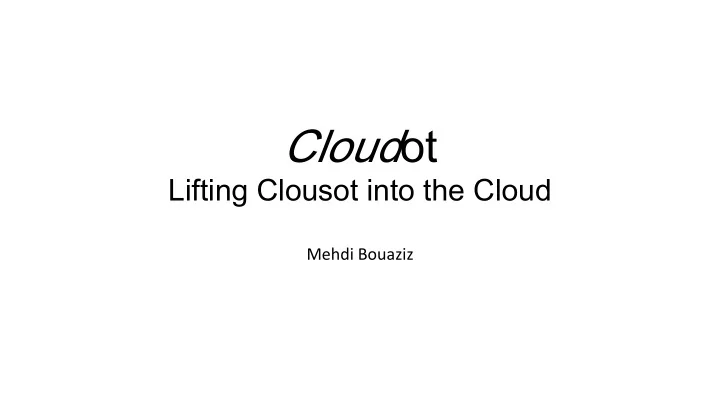

Cloud ot Lifting Clousot into the Cloud Mehdi Bouaziz
Clousot today • Runs on a single core on the developer box • Input: assemblies + contracts • The analysis • Order the methods according to the call-order • Analyze bottom up • Infer postconditions, necessary preconditions, and object invariants • Report warnings and verified code fixes • Analysis of methods is sequential
The Goal • Bring Clousot into the Cloud Why? • Exploit the massive number of processors and memory • Faster and more precise analysis • Faster? Because methods are analyzed in parallel • More precise? See demo!
Let’s Demo!
Parallelization • What we parallelize? • The analysis of a single method? • Past experience: no gain in performance • Too much time lost in synchronization/abstractions/… • My internship: Parallelize the analysis of the methods • Re-architecture of Clousot to make it distributed • Workers (analyzing methods) can be local or remote • Provide a structure (services) that can be easily ported to Windows Azure
High level algorithm for Cloudot • Slice the input assembly into smaller assemblies • The minimum analyzable units • Slices are pushed into a queue • Workers pop slices from the queue and analyze them (as usual) • Results are written into a shared database • Including the new inferred contracts • All the dependent methods are re-added to the queue
Theory: Chaotic Asynchronous iterations • We do not compute an order on methods anymore • Method analyses are chaotic and asynchronous • No synchronization! • Compute a global greatest fixpoint (gfp) • Method contracts are (Top, Top) at the beginning and then refined • Is it really the gfp? • Th. [Cousot78] If the analyses are monotonic then it is the gfp • Are our analyses monotonic?
Theory: Monotonicity… • No, we do not have it. Two reasons: • Widening • Absence of best abstraction • Issue also for finite domains • Have examples where inlining is less precise than modular analysis! • Problem can be remediated by forcing monotonicity • We can formalize all of this with nice Greek letters ;-)
Back to practice: Services • Same interface for all consumers • Based on WCF (magic for Francesco) • Can be hosted in: • A console, for debugging • A Windows service, for the Visual Studio extension • Speeds up small analyses by saving on Clousot initialization time (4 sec) • Our regression tests went 2x faster, without parallelization • A Web service, for RiSE for fun • A cluster or a cloud, for larger analyses
Slicer • Goal: do not ship a big dll file to analyze just a part of it • Given a .Net assembly and a set of methods M, generate a smaller analyzable assembly containing: • The methods M • Fake versions of types/methods/properties/fields visible from M • Their contracts, object invariants, contract classes • Debugging information (pdb file)
Queue • When we want to add a slice to the queue • Compute a snapshot: basically a hash of the inferred contracts found by prior analyses on the methods it depends on • If not already computed -> add it to the todo list • Remove all previous versions of this slice from the todo list • Prioritize the queue as you want: FIFO, smallest, fastest slices first, etc.
Conclusions & Future • Cloudot: a distributed version of Clousot • Port it in the cloud: Azure? Amazon EC2? …? • How difficult to port a .NET service into Azure? • Balance slices using timing information from fixpoint computation • Use inferred pre-state and post-state, object invariants (my prev. internship) • Experience on large assemblies (Dynamics) • … • Write a paper
Thank you! In particular to Mike Barnett for all the hard work on the slicer!
Recommend
More recommend